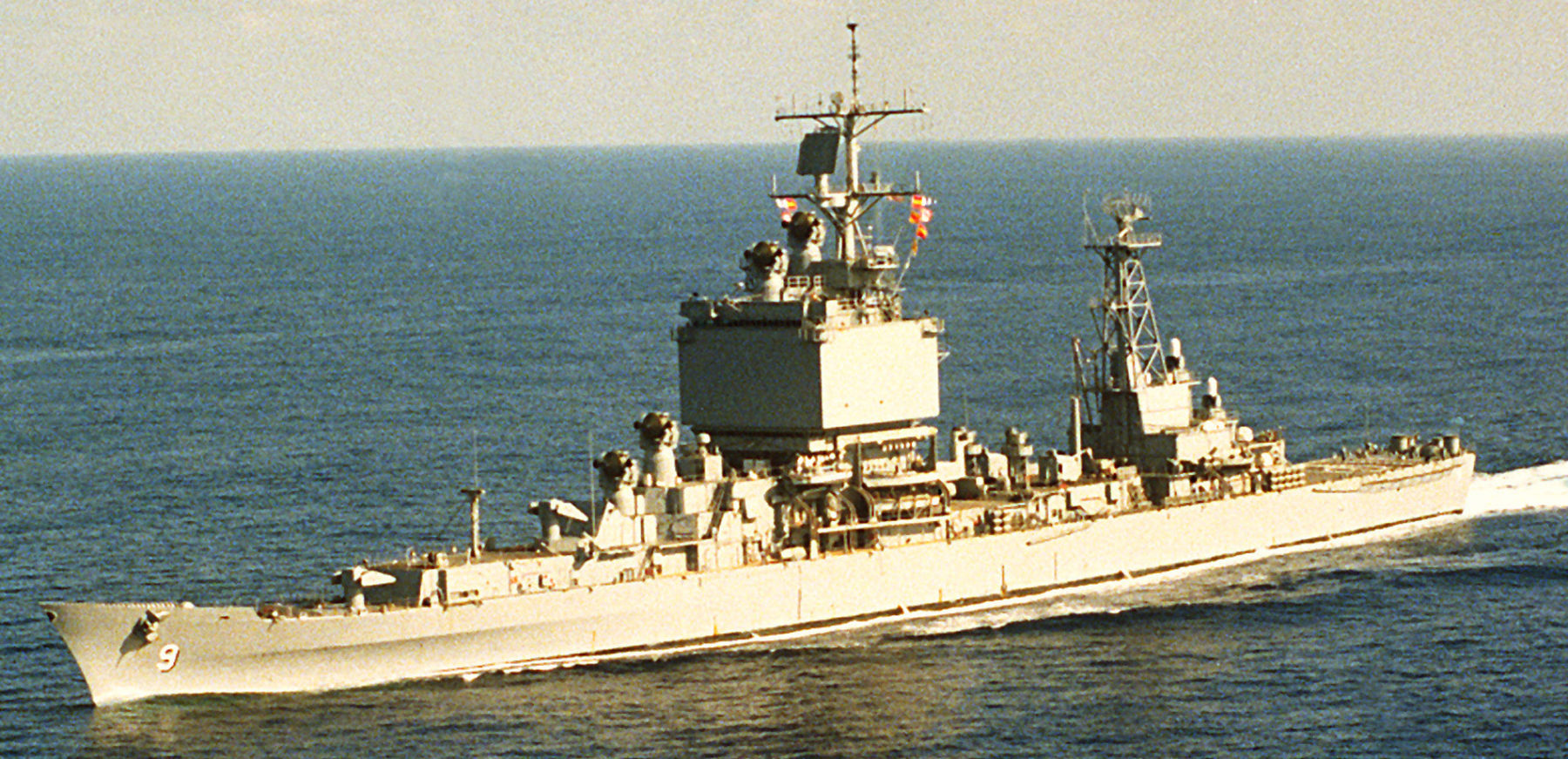
Missile Cruiser USS Long Beach
 Nuclear-powered missile cruiser
Nuclear-powered missile cruiser
US Cold War Cruisers:
Worcester | Des Moines | Juneau | Boston | Galveston | Providence | Albany class | Long Beach | Leahy | Belknap | Bainbridge | Truxtun | California | Virginia | Ticonderoga | Strike Cruiser (CSGN)This great cruiser is probably as famous as the aircraft carrier USS Enterprise, her ‘sibling’ in many ways. In fact, she was the first nuclear-powered cruiser ever built, the first USN cruiser built after the Second World War (the conventional Worcester and Des Moines were laid down during WW2) and the first without cannons as main armament. She was studied as a “missile frigate” in the early phase of the project in 1955.
She shared with USS Enterprise the massive SPS-23 radar, and the long-range sonar SQS-23 built in the bow, and associated with the ASROC launcher. Stabilities issues forced some care in the way the superstrcture was built, using stability tricks, and raising the bow. Her C1W reactors were a more modest version of those deployed on USS Enteprise, and delivered a total of 80,000 hp, enough for 32 knots and more if needed.
Her main career’s peak was to see combat in Vietnam, in the 1960s and early 70s, gaining units commendations and battle stars. In the 1980s they were many thoughts of modernization and conversion into an AEGIS type cruiser, but she lacked stability for extra additions and went on with a limited upgrades set. In the end, she was deactivated in 1994, after 33 years of service. She would remain alone in her class, the US Navy focusing on a relatively cheaper, moder modern alternative which became the California class in 1972, and later the Virginia class (1974) plus the singular, experimental Truxtun and Bainbridge built just after Long Beach, which showed the way and refined the concept.
In 1979, the magic of nuclear power was all gone and priorities of the USN had changed for the surface fleet, under the Reagan presidency. The next decade would be one of a large class of conventionally-powered missile cruisers, the Ticonderoga, compensating with their revolutionary AEGIS system. Although nuclear power resurfaces here and there in recent publications, this costly solution is no longer thought after, especially after the enthusiastic depiction in the 1950s of an “all-nuclear fleet”, down to destroyers and frigates.
Concept & Design Development
Development of naval nuclear reactors
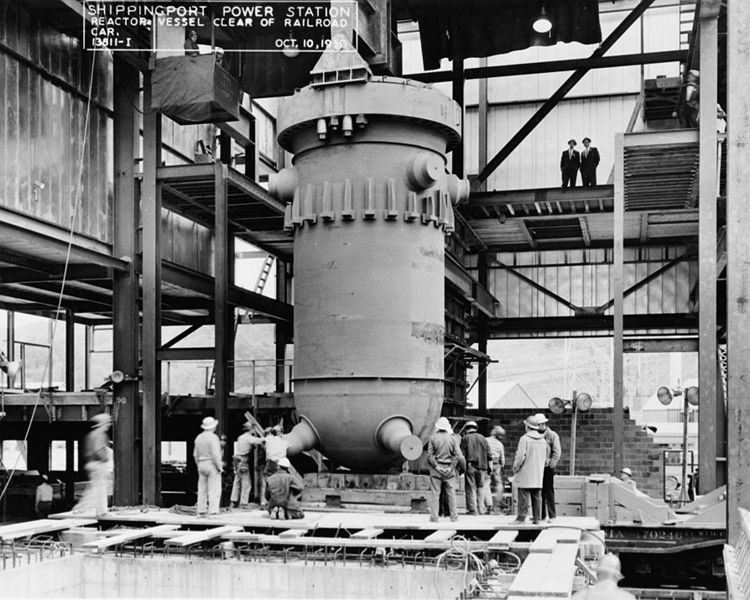
Shippingport-Reactor-Vessel
Work on nuclear marine propulsion started in the 1940s, the first stable test reactor bing operational in the USA in 1953. The genesis of the world’s first nuclear-powered cruiser goes all the way back to the “nuclear club” of the 1950s comprising some of its most ardents proponents, notably Admiral Hyman Rickover, for submarines (the first nuclear-powered submarine was USS Nautilus, put to sea in 1955, sustaining 20-25 knots submerged for weeks on end and a parallel development to the Skate-class with a single pressurised water reactors).
But also Admiral Forrest P. Sherman, Chief of Naval Operations (CNO) in 1949, which proposed a nuclear-powered aircraft carrier. But technology was still in its infancy at that time. Development work only started in 1951, and indeed conducted to successful tests in 1953, but halted by a national security council order. It was a distant relative of the 1946 X-10 at Oak Ridge, Tennessee, a production facility for radioisotopes, which export was soon shut down. The first attempt by the U.S. Atomic Energy Commission promoted a peaceful usage of nuclear power (President Eisenhower’s “Atoms for Peace” speech at the end of 1953).
The program was resumed in late 1954 with the establishment of the large ship reactor project. This formed the foundation of the surface ship nuclear propulsion program, going up to the completion of the last cruiser of the Virginia class, USS Arkansas, in 1980. Typically the problematic of the naval nuclear reactors needed to be of simpler and far more compact construction than land installations, which could boast 1600 MW and more, while a much smaller marine one was limited to a fraction of this, 200 or 300 MW. But in addition to the compact a reactor at sea needed to be more self-sufficient with better automation in control and maintenance, and requiring a smaller crew.
All these challenges led to the pressurized water type reactor. What led to this was a set of solution for:
-The need to use components subject to greater stresses, using tight spaces, and thus, must generate higher power per unit of space.
-The need to work flawlessly under adverse condition, vibration, hull twisting, pitching and rolling, shocks in heavy seas
-The need to endure seawater corrosion complicating maintenance and specific shutdown mechanisms not relying on gravity.
It was established it needed a smaller core, but in a tighter space and with a highly enriched fuel. The advantage was a less extensive shielding for the crew. That too was a problem, making a difference between surface vessels and submarines. In the latter this shielding, generally lead, was part of the ballast. On a ship subjected to stability issues, it had to be placed in the best location, complicating conception.
In the end, The Mark 1 reactor led to the US Atomic Energy Commission was capable of 60 MW, in Shippingport, Pennsylvania, starting in 1957. Westinghouse designed the first fully commercial pressurised water reactor of 250 MW, Yankee Rowe, starting operations in 1960, and the boiling water reactor (BWR) developed by the Argonne National Laboratory (Dresden-1, 250 MW) designed by General Electric also in 1960. They were posterior to the C1W design used for USS Long Beach. The development was simpler than for USS Enterprise, which started with the Westinghouse Electric Corp. at the Idaho National Engineering Laboratory (Arco) operating from in October 1958 and composed of A1W-A and A1W-B operating in tandem on one turbine. The A3W reactor was intended at first for USS John F. kennedy, but cancelled and further refined to end in the Nimitz class, as the A4W.
Genesis of the nuclear escort
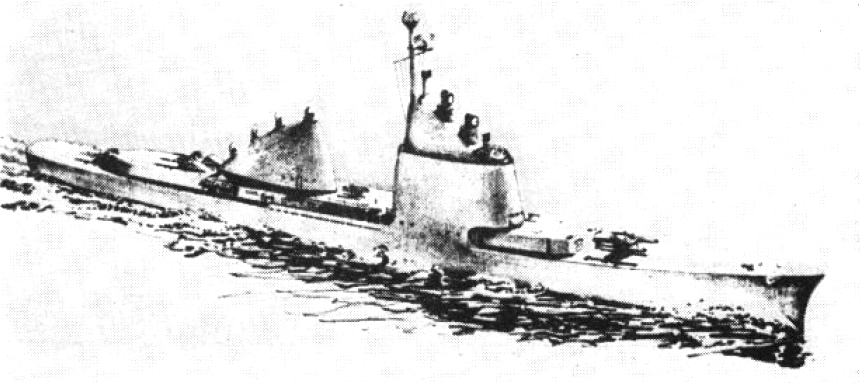
Artist Impression in 1956
All of this eventually led to USS Enterprise, powered by eight Westinghouse reactor units in 1960. It would remain the largest number of reactors ever put on a surface ship. It was in the FY1958 program, and USS Nautilus, FY1952 program. The admiralty soon realized that the unlimited radius of action of their precious carriers was not matched for its conventionally-powered escorts. Unless having a system of frequent roll of escorts along the way, another option was a nuclear-powered escort, unsuring a close protection at all of the new carrier. Therefore at first in 1955, a nuclear “frigate” was first thought after; It evolved to become a cruiser, programmed in the fiscal year 1957, so one year before CVN-1, the carrier she was supposed to escort.
Indeed, USS Long Beach preceded USS Enterprise, although they were launched at similar dates, and to gain time, engineers working at first on a “frigate” took a 1945 design light cruiser hull, similar to the Worcester class, but smaller. The Navy looked at building a new and pure missile cruiser. The impetus was led by CNO Arleigh Burke at the time, which developed an interest both for nuclear powered surface ships and missiles. Most of these early design plans included provision for the new and promising Polaris missiles in development, making these additional nuclear ballitisic capable surface vessel, in complement to the planned SSNBs. At the time, cruisers were seen as the best hard-hitting, offensive platform after an aicraft carrier. Initial design cost estimates went to around $90M but this was too optimistic.
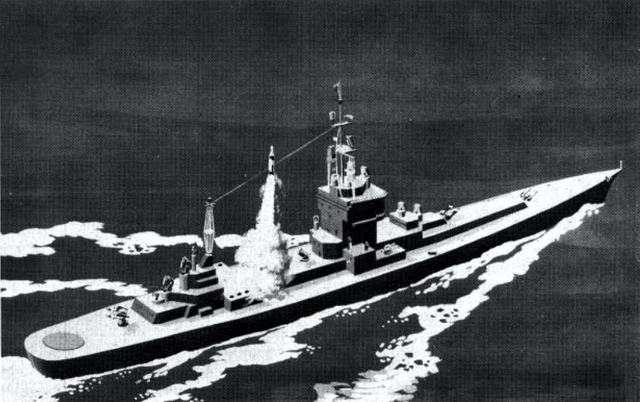
Artist Impression of the Polaris-version in 1961.
There was also the desrire to include a powerful, comprehensive ASW suite too making these cruisers an all-around weapons platform, addressing medium/short range air threats, surface threats and underwater threats with the same potency. It was capable of supporting independent operations like the cruisers of old (and sailing frigates) rather to be only stuck to a carrier escort group.
Initial efforts focused on nuclear frigates/destroyers, not cruisers. However it soon became apparent that a nuclear power plant just could not fit in a 140-150 m hull. A larger one was needed, thus entering cruiser’s realm. The change of class was an important one, probably made in 1957.
It was also realized the hull size dictated a suite of larger, more powerful weapons suite to justify the size of the ship, including for example the ability to shoot down high altutide soviet bombers, and distant targets with cruise missile. Design cost estimates then spiralled upwards to a conversative $150M in 1957. The Navy also recognized that nuclear power was needed to escort the new nuclear-powered carrier itself.
(…) Dispersion is increasingly important in a nuclear environment. A nuclear cruiser in particular should be able to operate alone against submarines, aircraft, and enemy missiles, although her primary role in non-nuclear war might well be within the task force screen. The ship would not be able to handle a mass raid, but she would have to be able to shoot down several aircraft in quick succession.
CNO Adm. Arleigh Burke about escort versus independent operations
When the Ship Characteristics Board started work with the bureaus they were planning essentially a very powerful fast task force escort, but significant disagreement existed between between them and CNO Burke and naval historian Friedman note about this:
(…)the ship radars had been optimized for task force command and control, not for the much more limited needs of an individual unit armed with weapons of limited range.
He also noted that the main design goal became not warfare but just to test introduction of nuclear power for the surface fleet, and the weapons fit was not to be totally adequate for its size, which was designed to accept nuclear reactors in the first place.
SBC 169 is finalized and accepted
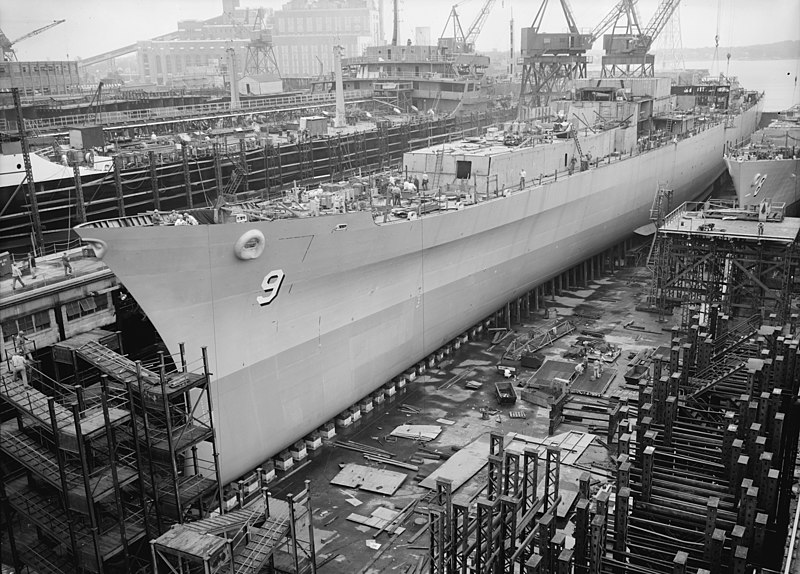
Long Beach under construction in July 1959
The hull was lengthened, to reduce resistance, and meet the designed speed requireed, of 30 kts. All designs led to the SCB 169, the real ancestor of the Long Beach, included in the FY57 budget. Early estimated put a hull 720 feet long overall, 16,000 tons displacement, which was aove a worceester class and closer to a Des Moines class. But the hull being redesigned and expanded it allowed for an open space just aft of the bridge “box”, first planned to accommodate Regulus cruise missiles in silos. But it was changed to four Polaris missile launch tubes and eventually in the last redesign, to 5″/38 caliber gun mount plus the ASROC system.
USS Long Beach was the last cruiser built with the old WW2 hull style as all subsequent ones would adopt a fuller, more modular hull form such as the conventional Leahy class (DLG-16), Bainbridge (DLGN-25), Belknap (DLG-26), Truxtun (DLGN-35), California and Virginia, Ticonderoga (based on a Spruance hull to gain time). From the FY1957 authorization, 1958 was spent finalizing the design while
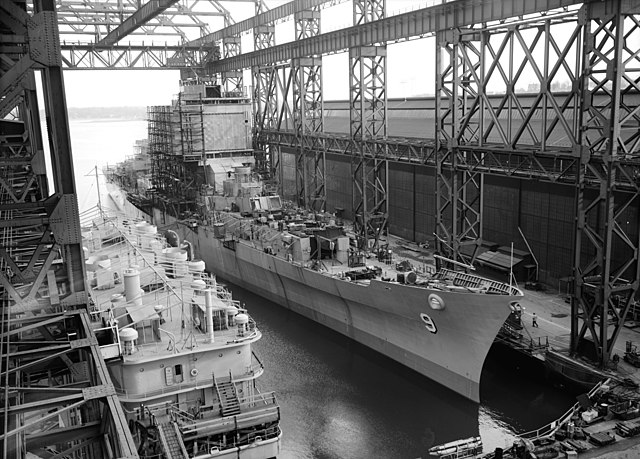
Long beach fitting out in 1961
Originally ordered as CLGN-160, reclassified as CGN-160 in early 1957 she became CGN-9in July, until the end of her life. Her keel was laid down on 2 December 1957 at Bethlehem Steel Co., Fore River Shipyard (Quincy, Massachusetts). She was launched on 14 July 1959, sponsored Mrs. Marian Swanson-Hosmer (wife of Rear Admiral Craig Hosmer) and Congressman of California. Her cost was reported to be $320 million ($2.9 billion today) way over budget compared to tgh $250 million declared to the Senate in 1957. During completion, in January 1960 there were cases of degaussing electrical cables cut in three places. The operationhad to be performed again and that was the second of three incidents at Fore River Shipyard that year. Enquiry never led to conclusive results.
Detailed Design
Hull and general construction
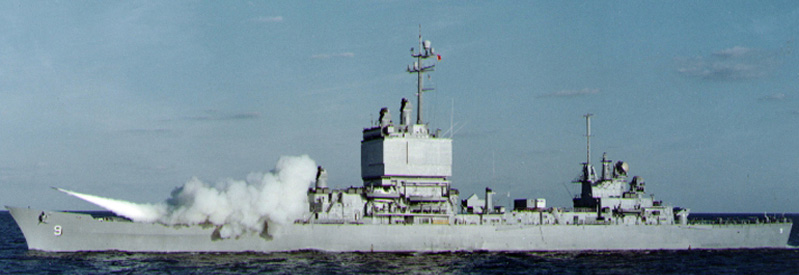
USS Long Beach launching a terrier missile in October 1961
Outside the hull which had a very slender waterline, a lot of flare foward and seen from above an elliptic shape, and an additional bulwark at the prow to manage waves, the Long Beach design was characyerised by its impressive and tall, in fact massive-looking box-like superstructure. The main reasoning behind was to contain the SCANFAR system: AN/SPS-32 and AN/SPS-33 phased array radars. The latter were massive and thus, the decks were located below and above them, creating the large box.
This choice, similarly adopted for USS Enteprise, was creating problems. More on the latter. Indeed, while CVN-1 was quite wide and stable, the slender hull of USS Long Beach meant it became not only a massive sail in high winds but a major stability issue as a whole. USS Long Beach would remain experimental because she was the experimental platform for these radars. They were indeed later replaced by the much smaller AN/SPY-1 phased array systems on the Aegis Ticonderoga-class and later Arleigh Burke-class, still massive, but at least more manageable in height.
Photos when commissioning and for some time show AN/SPS-33 panels were not installed right away. The bridge was thus “open to the winds”. Nevertheless, this gave USS Long Beach the highest bridge of any warhip in the USN, even the converted Albany class cruisers. Construction called for steel, mostly for the hull, and some 450 tons of structural aluminum for the superstructure, despite the potentual fire hazard. It was the only way to keep the weight down. Because of this unusually high aluminum she was given the voice radio call sign “Alcoa”.
Powerplant
USS Long Beach was propelled by two nuclear reactors, one for each propeller shaft. The Westinghouse C1W were coupled with General Electric turbines for a total ouptut rated for 80,000 shp (60 MW) on her two propellers. The C1W are reportedly very similar to the A2Ws of the USS Enterprise, but probably uprated.
The C1W reactor was a pressurized water reactor which navy designation stands for:
C: Cruiser (platform); 1: First generation core designed by the contractor; W: “Westinghouse” as contracted designer. This type was used exclusively designed for the Long Beach-class and only nuclear reactor explicitly earmarked for a cruiser with two powering corresponding geared turbines. All subsequent nuclear cruisers were powered by “D”-class (for “destroyer”) reactors: The D1W and D2W.
Performances-wise, she reached a top speed of 32 knots as a planned (56 kph) and her range of course was unlimited, only needed a change of core every ten years or so. This however was a major operation which needed a prolongated stay in port. It could not be done at sea. It is not known if speed tests beyond 32 knots were made on her sea trials, but in theory the reactors “pushed” to their limits could have provided more power and thus speed in excess of 38 kts if needed or more. There were dangers of vibrations though, detrimental to the radars, and of course issues in cooling the reactors in that case.
Armament
Long Beach in 1961 and 1986-90
The ship was originally designed as a radical “all-missile” cruiser. But realism prevailed and she was fitted with two 5″/38 caliber gun mounts amidships, by order of President John F. Kennedy which was not trusting 100% the missile systems and wanted a backup.
The initial armament when in construction was to be:
-Rear Talos launcher (long range SAM), 80 nmi (150 km).
-Two forward Terrier (medium range SAM) 30 miles (48 km).
-RUR-5 ASROC ASW system torpedo/depth charge (short-ranged) 10,000 yd (9.1 km).
-Two triple 12.75 inch torpedo launchers/Mark 46 torpedo for ASW.
-Two 5″/38 guns for surface/shore bombardment at 18,000 yd (16 km).
When revised in the 1980s the armament was finally modified comprised as the following:
- Two fwd Mk10 launchers for the Standard SSM/SAM extended range missiles
- Two quadruple mounts RGM-84 Harpoon anti-ship missile aft, later relocated to the aft mast
- Two Phalanx CIWS, aft side of the aft mast.
- Two quadruple armored box launchers were added for the BGM-109 Tomahawk cruise missile aft on the fantail
- 5″/38 guns and the ASROC retained
- Several 12.7mm (50-cal) installed

Firing a Terrier missile, October 1961
RIM-8 Talos
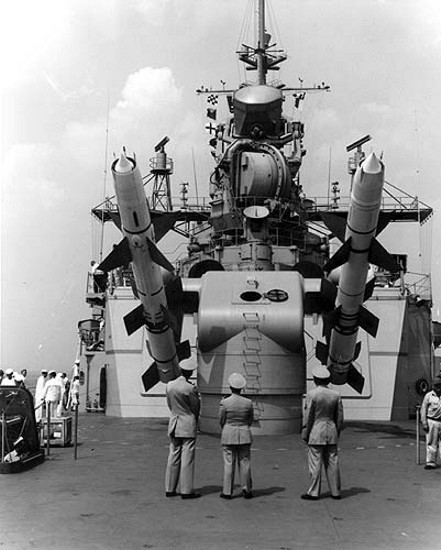
Talos system on USS Long Beach
The early long range SAM of the USN, designed to shoot down high altitude bombers (1958). On 9 September 1961 it was installed on CGN-9, three Mk 7 and the Mk 12 GMLS with 8×AN/SPG-49 RADAR. But she had her Talos launcher removed in 1978. It was capable of flying to Mach 3 at 24,400 m (80,100 ft). 1
RIM-2 Terrier

Firing her terrier missile, October 1961.
The early medium/short range SAM, developed in the 1950s from the Bumblebee project. This 3,000 lb (1,400 kg), 27 ft (8.2 m) long missile powered by solid fuel rocket had a range of 17.3 nmi (32.0 km) and 80,000 ft (24,000 m) ceiling at Mach 3, guided by Semi-active radar homing. Removed and replaced by the Standard Mk.10.
RUR-5 ASROC
The standard USN ASW system, also able to deliver short range SSM (antiship missiles). It was located amidship, behund the towering forward superstrcture and the aft one. It was 8-cell system (32 reloads) with a 360° traverse and good elevation, which comprised in normal ASW operation a missile acting as carrier for either a standard Mk46 homing torpedo or a depht charge on target. All eight could be fired in short succession. Among others, it could carry the W44 nuclear depht charge if needed intoduced in 1961. The honeywell missile was subsonic, with a range of 6 mi (9.7 km) to 10,000 yd (9.1 km) on later versions. In the latter case, the nuclear warhead was 10-kiloton, so the distance was barely sufficient to protect from the effect of its blast and radiation. The system was phased out in 1989 following the nuclear ban.
2×3 12.75 inch torpedo launchers Mark 44
Designed to launch two triple Mk.44 and later Mk.46 12.75 in (323 mm) homing torpedoes for ASW warfare, they were located amidship close to the superstrcture on eaither side, reloaded. The Mark 44 was developed from 1957, and launched also by the AD-1 Skyraider. It was powered by a 30 hp (22 kW) Electric engine, to 3.4 miles (5.5 km), 1,000 yards (910 m) in depth, at 30 knots (56 km/h; 35 mph) and guided by Helix search. In the 1980s they were replaced by Mark 46 models with had better performances and homing caracteristics.
Sensors
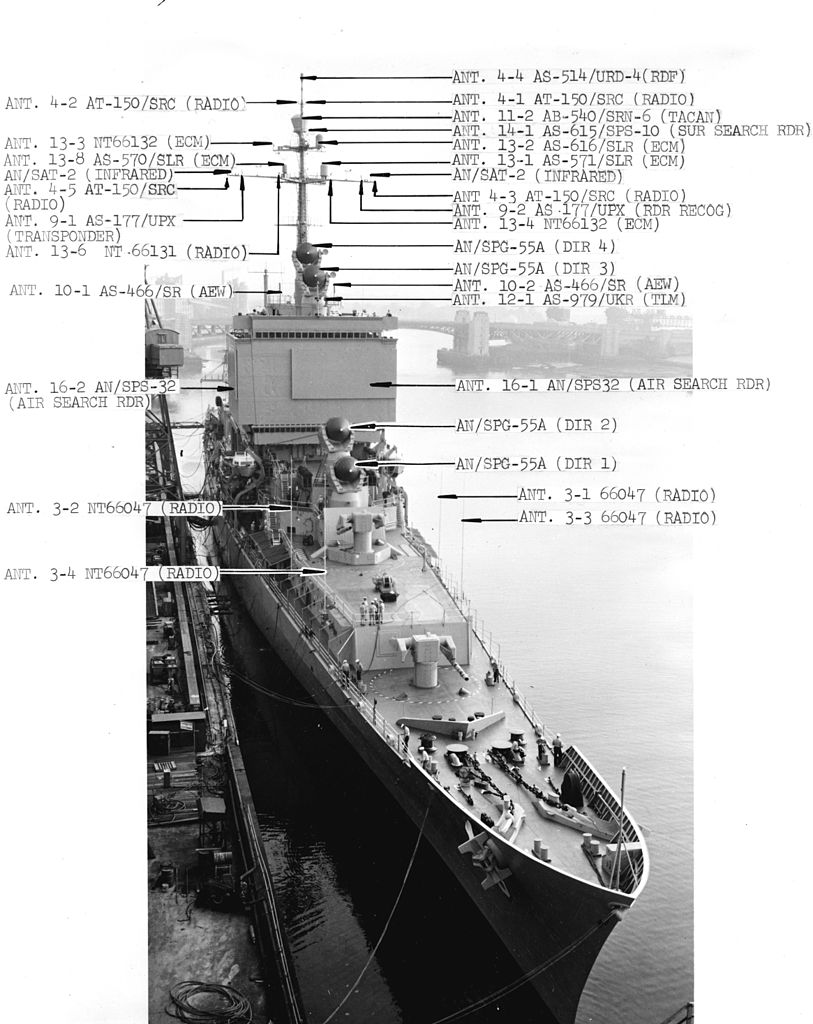
About the SCANFAR system: The caracteristic box like housed the AN/SPS-32 and AN/SPS-33 phased array radars (see below).
The AN/SPS-32 was a bearing and range radar.
The AN/SPS-33 was a target tracking radar. For the first time it enable the cruiser to simultaneously track and respond to several aerial and surface threats at the same time. It was the grandaddy of the AEGIS system.
Prior to the development of SCANFAR, the Navy tried to have its anti-aircraft weapon system combined with a very advanced radar system called the the AN/SPG-59. It was to target long-range, high altitude threats with the new RIM-50 Typhon. The radar was an active electronically scanned array, doubling as long-range surveillance system, target illumination, and guidance system for the missile. The system was a world’s first and state of the art, but needed a large number of individual broadcast elements and ended too ambitious, unreliable and expensive.
SCANFAR was in part a simplified version of the SPG-59 with a main radar used only for surveillance, and target illumination assumed by existing radar systems used by the RIM-8 Talos or RIM-24 Tartar. What the USN leant was that using a single antenna for both search and tracking did not worked. So the system had two antennas combined, for surveillance and tracking, but three radar antennas in the end, making for a bulky system. The automatic tracking computer appeared in 1967 and with it, USS Long Beach was able to deal quickly with two North Vietnamese MiGs in patrol with the Talos.
In service, however, it proved to be “temperamental” due to its numerous vacuum tubes but the display was was good and enabled for the USN over-the-horizon capabilities. During her 1967 overhaul period, it was converted to solid state electronic board which lightened the superstructure by 20 tons. It was a S band radar with pencil beam function focusing a single radar beam on target, manually operated. It was later replaced by the AN/SPS-48E. In this “couple” the AN/SPS-32 was the horizontally wide rectangular antenna for air surveillance while AN/SPS-33 had a vertical narrow rectangular antenna, frequency-scanned in elevation and phase-scanned in azimuth.
AN/SPS-10 surface search radar: Two-dimensional radar by Raytheon Tech. introduced in 1959.
AN/SPS-12 search radar: L-Band, medium surveillance radar developed to detect aircraft and surface vessels, from 1953.
AN/SPS-48 3D air search radar: Electronically scanned array air search three-dimensional system by ITT Exelis (1966).
AN/SPS-49 2D air search radar: 2D long range air search radar by Raytheon providing contact bearing and range.
Two AN/SPG-49 Talos fire control radar
Two AN/SPG-55 Terrier fire control radar
AN/SQS-23 SONAR: Search, detection and tracking for surface/sub with audio and visual echoes, range 10,000 yds, int. 1958.
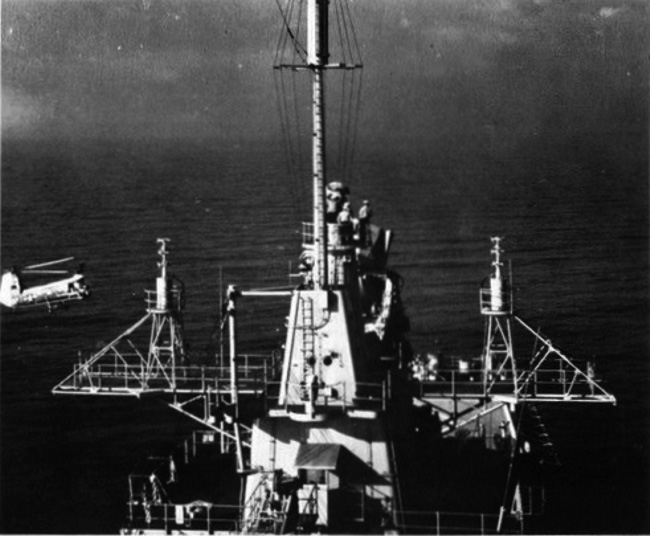
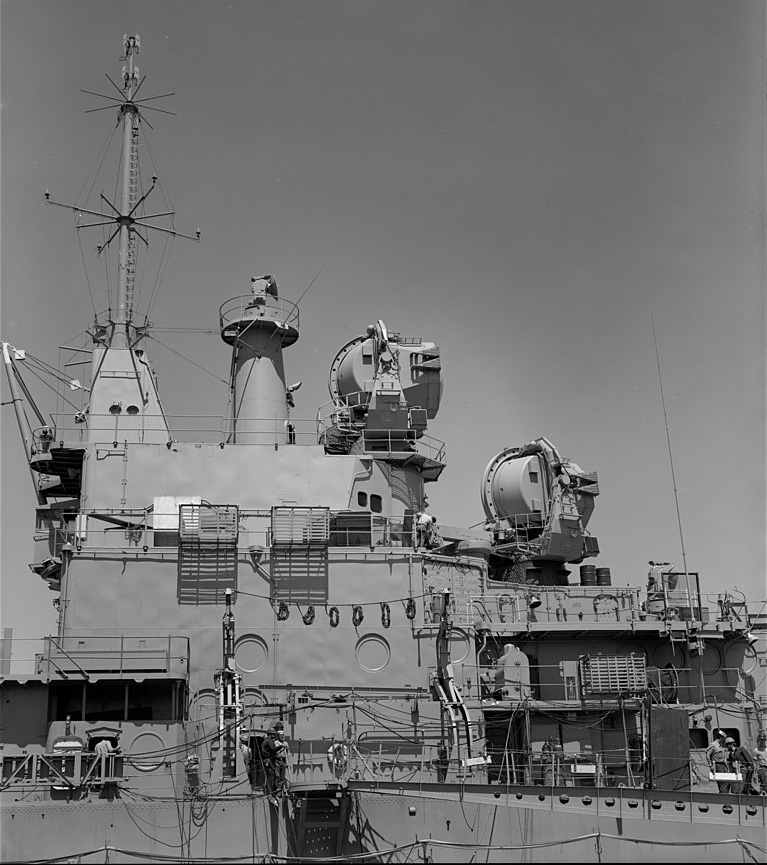
CGN-9 Aft mast
Helicopters
![]()
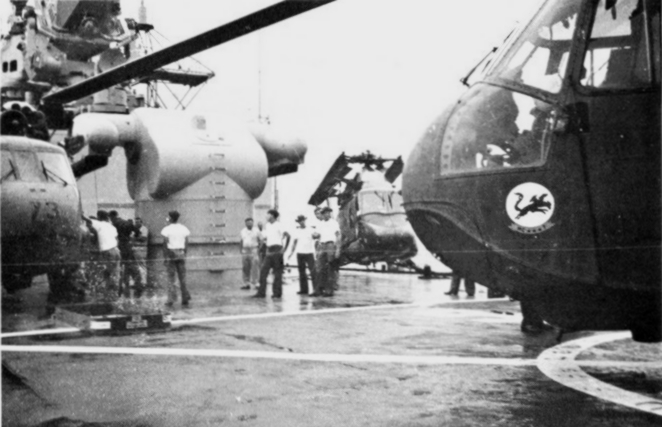
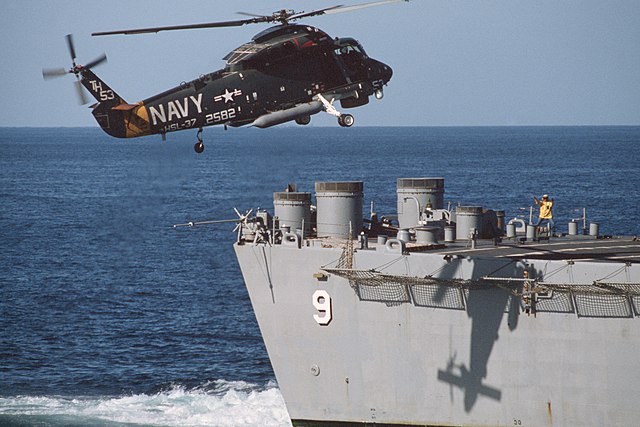
The aft deck section was occupied by an helipad, not that common apart for converted cruisers, with great capacity. It had helopad large enough for one, but provided support for an on-board Search and Rescue (SAR) helicopter unit made of two models. In her carrer she carried a variety of models, like the Piaeseki/Vertol H-21, but also the Kaman UH-2 Seasprite for its HC-7 Sea Devils unit of Vietnam fame, which in the 1980s, operated SH-3A Sikorski Sea King. Up to three were parked on the wide aft deck, including the one on spot; There was no lift no hangar though.

Author’s illustration of the USS Long Beach
⚙ Long Beach class specifications |
|
| Dimensions | 219.9 x 22.3 x 7.3 m ( x x feets) |
| Displacement | 15,110t standard, 16,600t FL |
| Crew | 1107 |
| Propulsion | 2 shafts turbines, 2 C1W reactors, 80,000 hp. |
| Speed | 32 knots (50 km/h) |
| Range | 2300 nm @ 27 knots. |
| Armament | 1×2 Talos AN (52v), 2×2 Terrier AA (120v), 1 ASROC ASM (20v), 2 x 127mm AA, 2 x 3 TLT 357mm (12 mk32 ASM torpedoes) |
| Sensors | Radar SPS-32/33, SPG-49, 2 SPW-2 fire lines, 4 SPG-55, Sonar SQS-23 |
Was U.S.S. Long Beach a white elephant ?
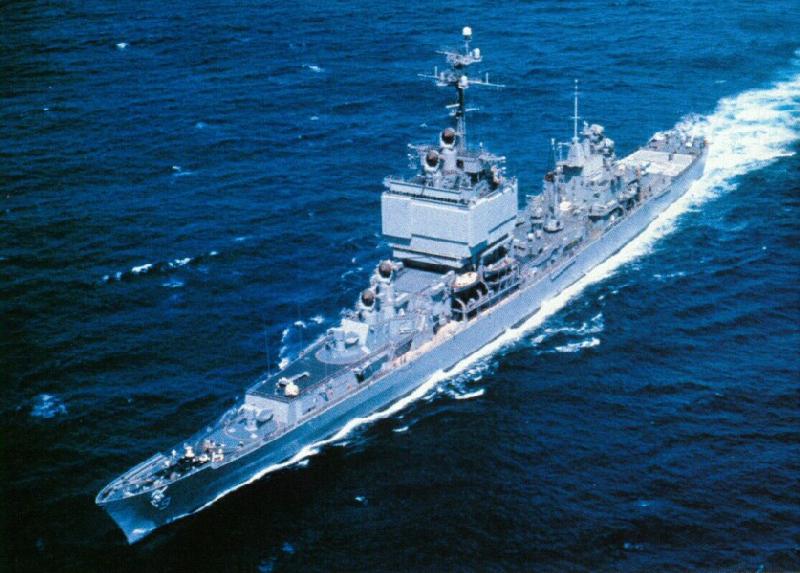
There are serious arguments in both ways – ie. she was a useful ship, paving the way for innovative vessels, but the general public’s perception through the lens of taxpayer’s money was that she was “US Navy’s folly”. She was to prove an all-nuclear fleet was a very potent asset, the Navy’s counterweight to the SAC policy of strategic bomber in the air full time. The Navy at least can argue having a task force at sea at all time. The Navy even went further before the senate and argued that a single nuclear-powered task group could replace two conventional ones, as generally the ships of a TG were always at some point in overhaul and supplying. Therefore, even if the ships were individually costier, they were far more often deployed and thus, their ratio maintenance-supply cost versus hours at sea fully in operational readiness was a bargain for US taxpayers.
But it did not accounted several crucial elements: If the ship’s power brought indeed unlimited range and autonomy at sea, the crew’s fatigue after many months at sea became an important element obliging the Navy to take the human element into consideration for mandatory, yearly periods of rest. It was at one point though of rotating crews at sea, a bit like replenishment at sea (RAS) operation, but using some sort of “suspended bridge” between vessels, or helicopter transport, but this proved impractical. RAS even offered a counter-argument to an all-nuclear fleet as the process started in WW2 was now well established and negated the advantages of a nuclear fleet.
In the end, referring to to Operation Sea Orbit, which was never repeated, the dream of all-nuclear powered task groups eventually proved to be a chimeric hope, and public a relations coup, but no much else. Only carriers are nuclear powered today and escort vessels are simply rotated, with multinational collaborations quite often lifting the burden of the USN. As an individual ship, wer are left to see that USS Long Beach’s whole concept was never repeated. The best argument against her was the vivid debate about the strike cruiser.
There was also the point of ship’s fatigue, independent of its propulsion. Her hull was in the same steel as others and she needed drydock time for basic antifooling and cleaning -like any other vessel in the navy. The non-nuclear elements in general also wore out, ammunitions supplies needed to be refilled, electronics and electric components would fail, etc. There was also the case of necessary upgrade as technology -especially for radars- and later missiles and ECM, needed upgrades to stay relevant (which was done in the 1980s). But with her old style WW2 hull with complicated shapes, she proved less modular than the Bainbridge and followers. Which were also wheaper. At last, her main justification was to carry the combined radar system seen as cutting edge in its day, SCANFAR, but it proved complicated, capricious at best and partly unreliable.
Even under the Reagan administration it was chosen wiser to use destroyer-size AEGIS vessels in large quantities as a cheaper way to achive the Navy goal without the use of a few very large and expensive vessels for basically the same missions. Even, the Kirov class revealed in 1978 never spurred the admiratly into believing equivalent vessels can be an answer. The “battle” between the Navy staff for the strike cruiser and the Senate was won by the latter. Instead it was theorized that more, cheaper vessels, was the answer, betting on technological edge. After all, the Soviet Navy in 1980 had no equivalent to AEGIS and several “Tico” could perform the exact same saturation fire as a Kirov, way faster. The USS Long Beach as a pre-aegis vessels was completely unable to be as potent. It is even remarkable that she served for 33 years and she was largely seen in 1991 a bit like a prestige vessel from a bygone time, a symbol of the Kennedy era like USS Enteprise.
Gallery
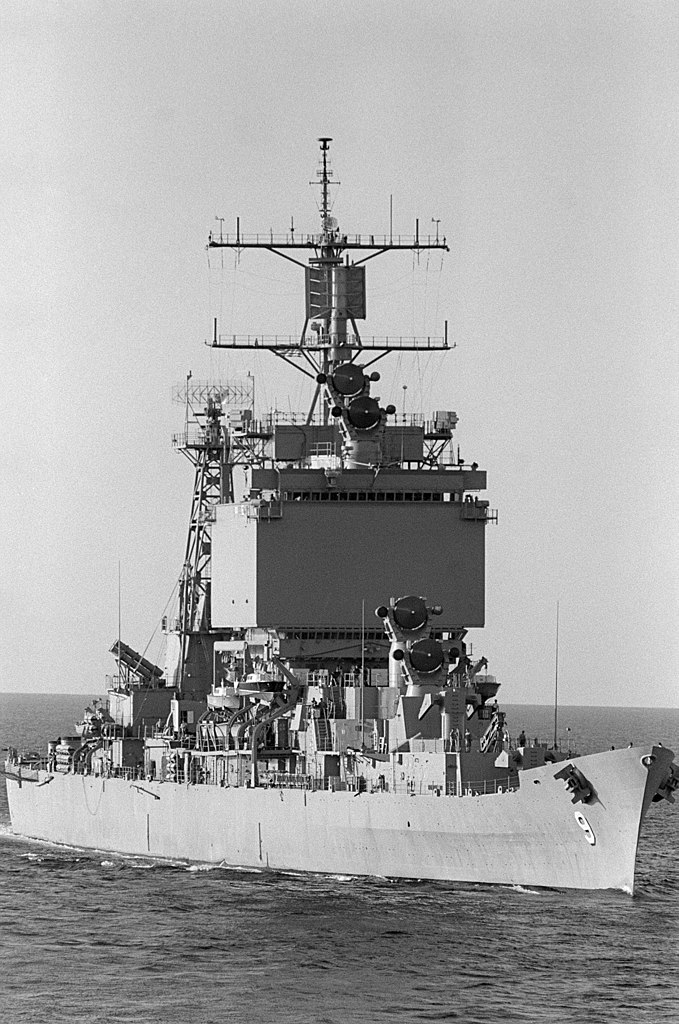
USS_Long_Beach_stbd_bow_view
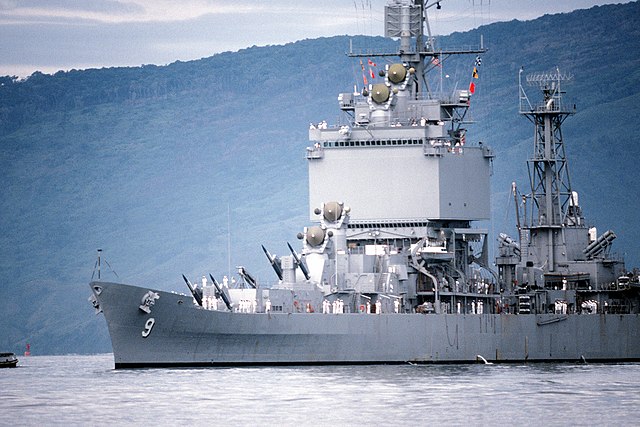
USS_Long_Beach_entering_Subic_Bay
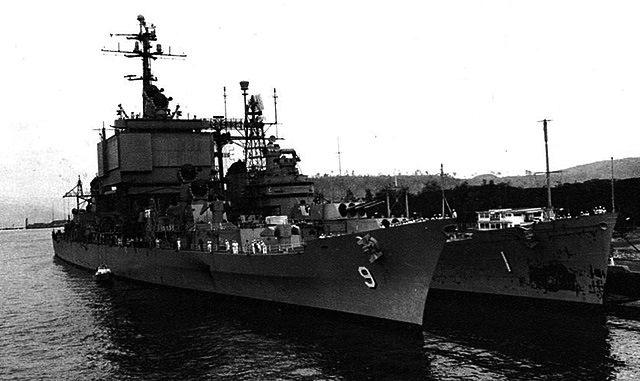
USS_Boston_USS_Long_Beach_docked_at_Naval_Station_Subic_Bay_Philippines_April_1967
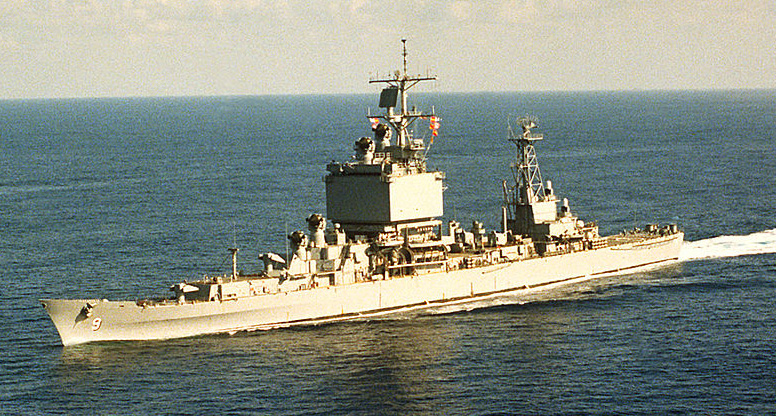
DN-SC-85-07293-Aerial_port_bow_view_of_USS_Long_Beach1983
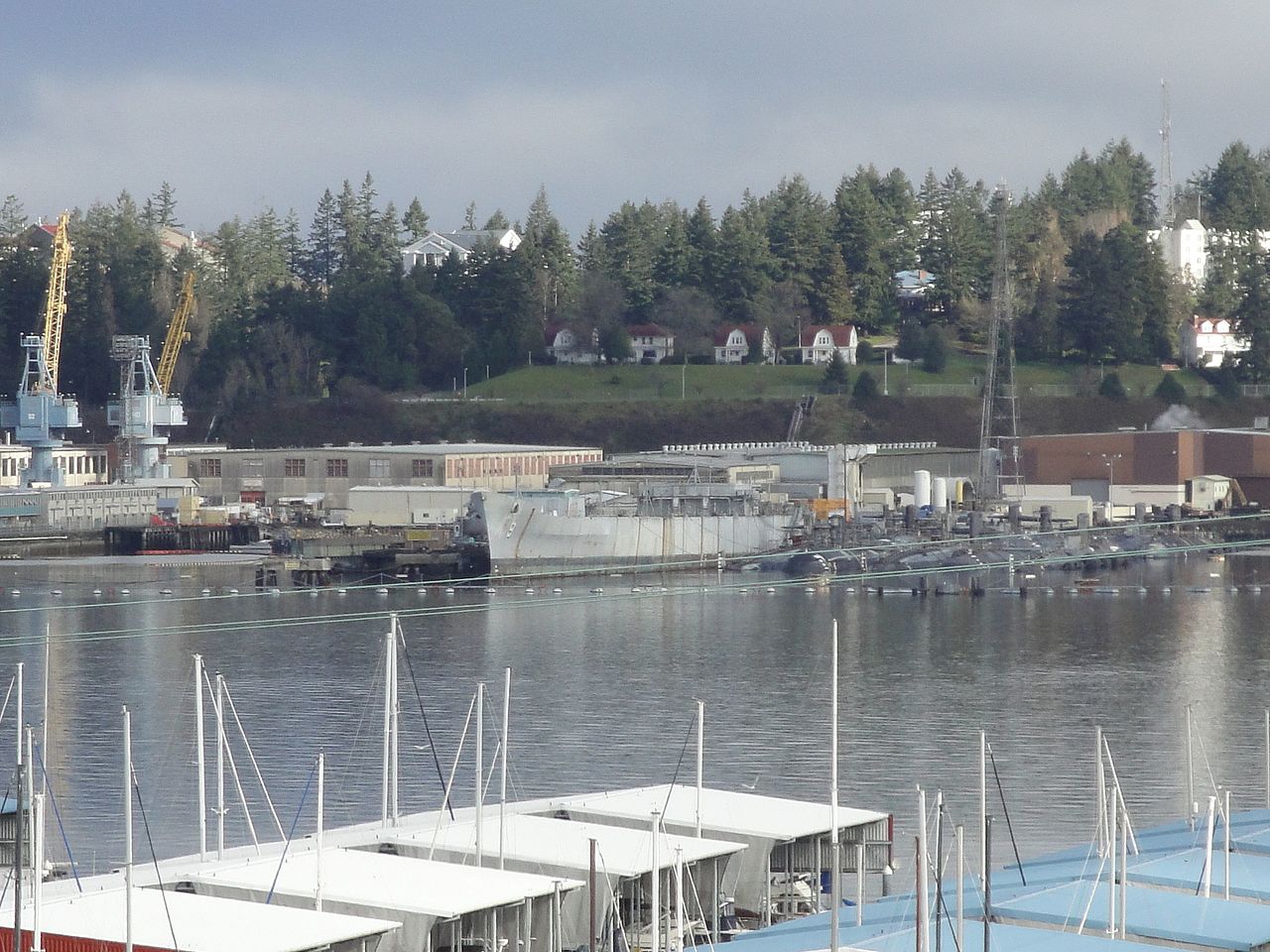
USS_Long_Beach_Puget_Sound_Naval_Shipyard_March_2011
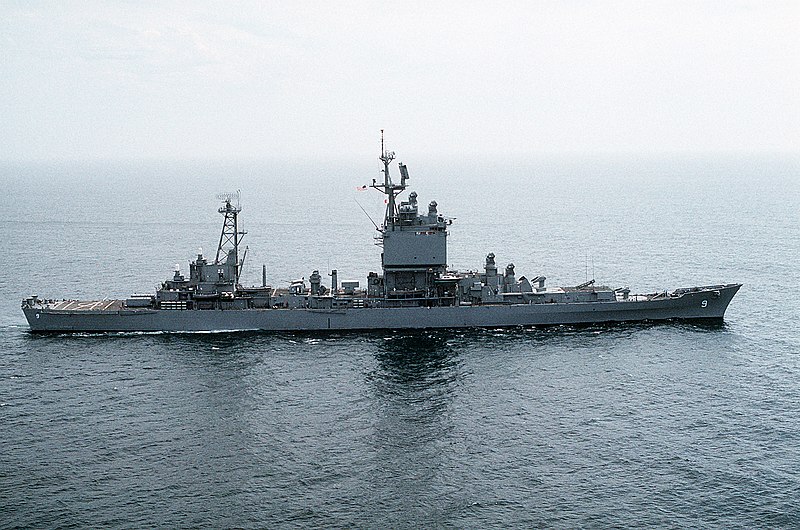
USS_Long_Beach_CGN-9_stbd_beam_view
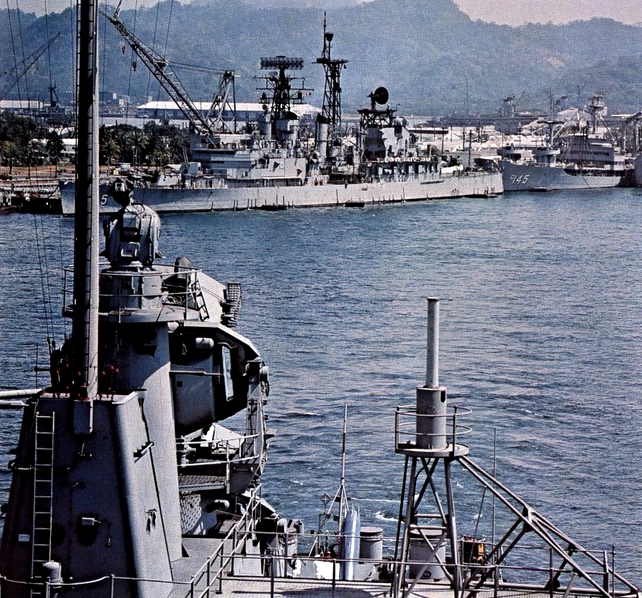
USS_Oklahoma_City_seen_from-long_beach_Subic_Bay_c1970
USS Long Beach’s carrer

USS Long Beach was commissioned on 9 September 1961 after four years of construction and a long fitting out time of two years, the phase in which cost srpiralled out of controlled. In a sense that was awaited, she was prototype and a very innovative ship, the first of her kind (and the last on some aspects).
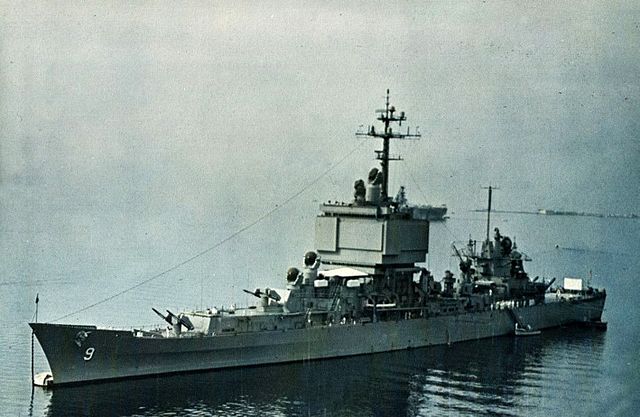
USS_Long_Beach_at_anchor_circa_1962
She was first assigned to the Atlantic Fleet, Naval Station Norfolk. After extensive shakedown tests and cruise she spent time fine-tuning all her complex weapons systems, electronics, and nuclear and propulsion, until 16 December 1961, and was reported to ba a very capable warship. Until 6 January 1962 she started her first missile tests off Puerto Rico. Her first foreign cruise was to reach Bremerhaven in West Germany. She arrived on 15 Januaryand made other courtesy calls in north European ports. The undelying strategy of these were clearly to reinforce the trust to NATO and US protection, a strong signal given to the allies and Soviet Union alike. Not warship was flagged as powerful and cutting edge like her at that time. She was the space age cruiser.
Back to Norfolk on 7 February 1962, trained off the east coast and Caribbean and by 10 April as reassigned to the Atlantic Fleet. There, she became flagship, Admiral Robert L. Dennison, CiC, and trined off North Carolina and Virginia. She hosted John F. Kennedy and Vice President Lyndon B. Johnson the first ellegedly being troyble by the absence of any gun aboard and asking for their addition.

Her first Atlantic yearly TOD ended in early 1966 for her first nuclear core change and overhaul in Norfolk and NAS Long Beach in California. She received new equipment at Philadelphia and made a refrseher cruise in the Caribbean. On 6 August 1963 she was reassigned to the Sixth Fleet, Mediterranean.
Operation Sea Orbit
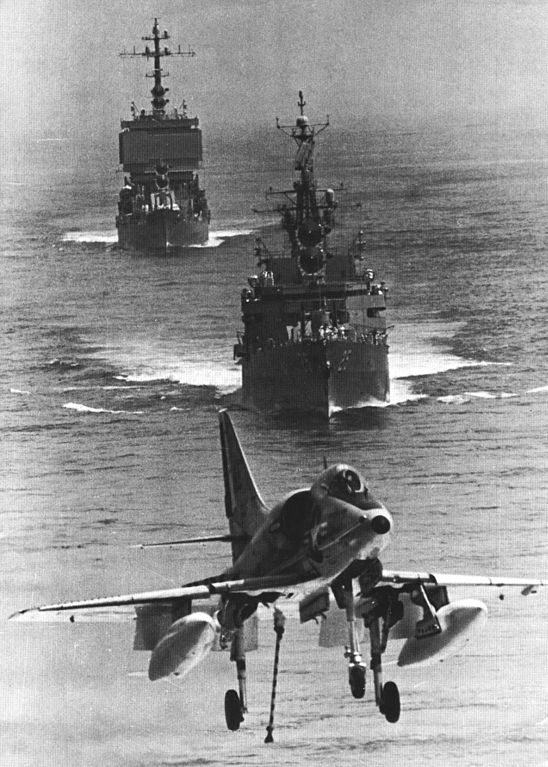
A-4C of VA-66 landing on USS Enteprise with USS Bainbridge and USS Long Beach c1964
Back to Norfolk for training, and Caribbean in April, she joined USS Enterprise (CVN-65) and USS Bainbridge, for a serie of cruises, as the world’s first all nuclear-powered task group, starting in May. They sailed with RADM Bernard M. Strean from Gibraltar for a round the world cruise, another PM exercize, called “operation sea orbit”.
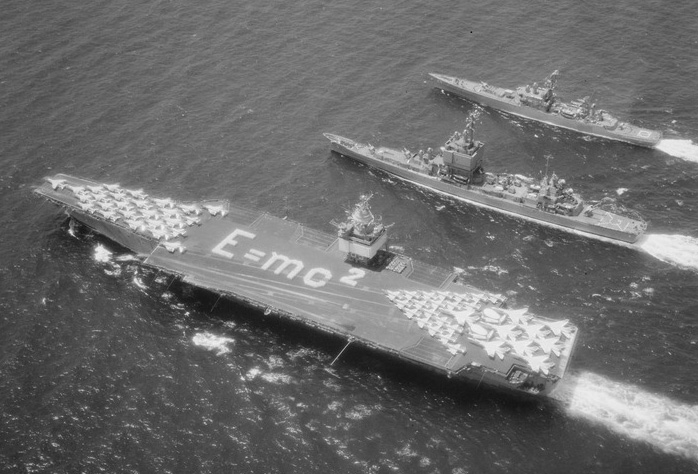
Nuclear fleet: USS_Enterprise, Long Beach, Bainbridge
This was recall of the good olf “Great White Fleet” cruise of in 1907-1909, showing the fleet’s capabilities without any fleet logistic support. She cranked up 30,000 miles in 58 days at 25 knots on average at sea but stopped in many places, each time visited by foreign dignitaries, notably Karachi, Melbourne, Wellington, or Rio de Janeiro, and back to Norfolk on 3 October 1964. Thos was followed by her usual winter Caribbean cruise and in June 1965 headed for the Global Strategy Conference at the Naval War College, Newport with VADM Kleber S. Masterson aboard, Second Fleet CiC, as flagship. She resumed training in Norfolk by June followed by upkeep and trabsfer to the Pacific Fleet from 28 February 1966. Her new homepprt was also her namesage, Long Beach in California (from 15 March).
Long Beach in Vietnam: The “Mig Killer”

USS_Long_Beach_docked_at_Long_Beach_2_January_1968
The summer of 1966 saw training in tactics and operations and on 7 November 1966 she departed for the Far East, used as a Positive Identification Radar Advisory Zone (PIRAZ) unit in the northern Gulf of Tonkin. She was to be sure of a safe return of U.S. strike aircraft, trying to use her advanced detection capabilities to spot enemy aircraft attempting to evade identification, hiding amongst returning friendlies. She also became a base for the SH-7 “Sea devils” Search and Rescue helicopter unit.
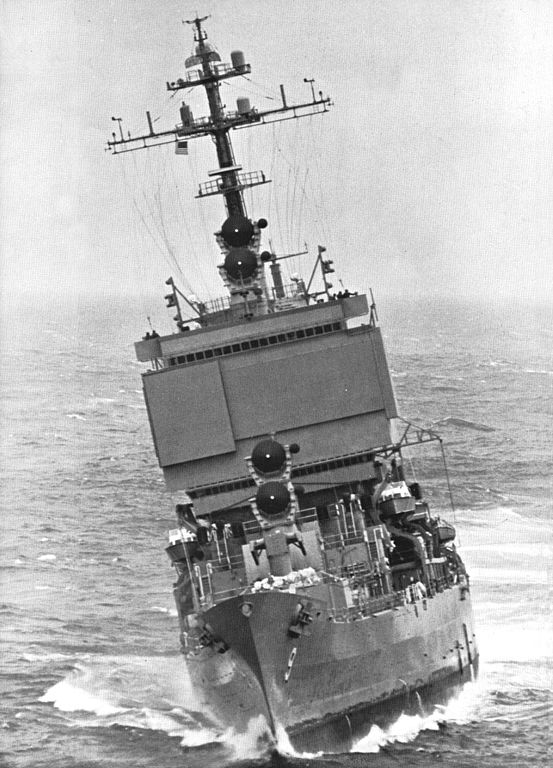
Bow view 1965
USS Long Beach helped shooting down an An-2 ‘Colt’ attempting to engage South Vietnamese vessls, by directing an F-4 Phantom II, playing the air intercept controller. She was back in Long Beach by July 1967 and returtned the next year for the Gulf of Tonkin. There, she managed for the first time to shoot down a MiG 21 jet fighter near Vinh with a RIM-8 Talos on 23 May 1968 at 65 miles (105 km). In June she shot down another one at 61 miles (98 km), while directed other MIG kills from fighters. She was the first vessels deployed in Vietnam to use her SAMs, later receiving a Navy Unit Commendation and Combat Action Ribbon on 26 April 1972 for her deeds at Đồng Hới.
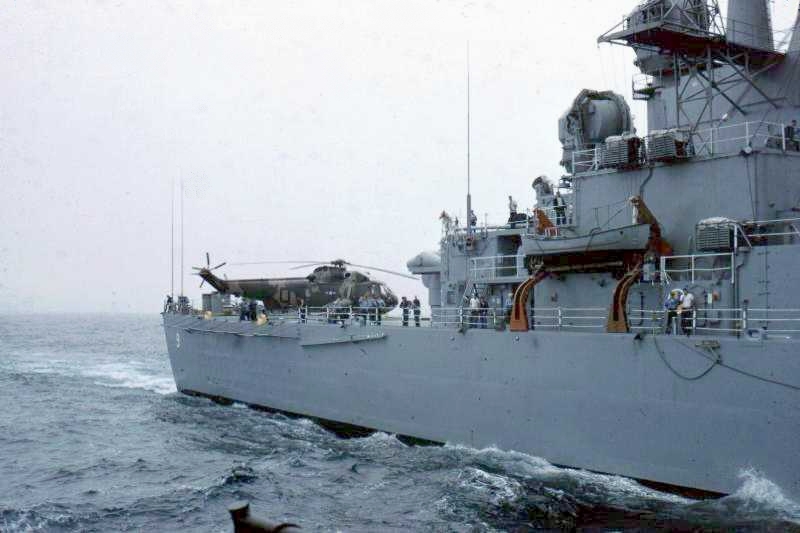
CGN-9_with_SH-3A_on_PIRAZ_duty_off_Vietnam_1967
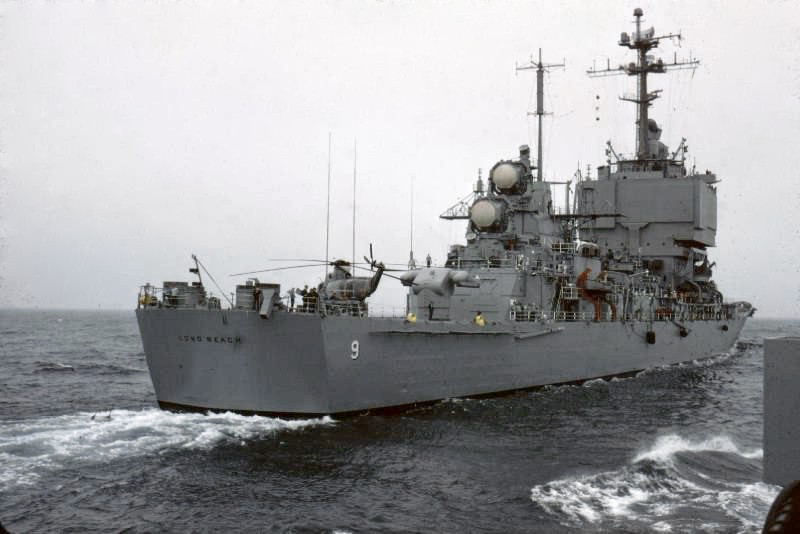
CGN-9_PIRAZ_MarApr1967
The seventies and eighties

USS_Long_Beach_underway_off_Oahu_on_9_May_1973
After Vietnam, she patrolled in the Western Pacific and Indian Ocean, always the centerpiece of USS Enterprise’s task force. In 1975 while now based in Naval Base San Diego, she took part in her first multi-national exercises, repeated in 1976 and 1977. Meanwhile, engineers at DARPA working on AEGIS identified her as the best contender for the new “strike cruiser program”. Eventually the program never went to conclusion as the Ticonderoga class was voted instead.
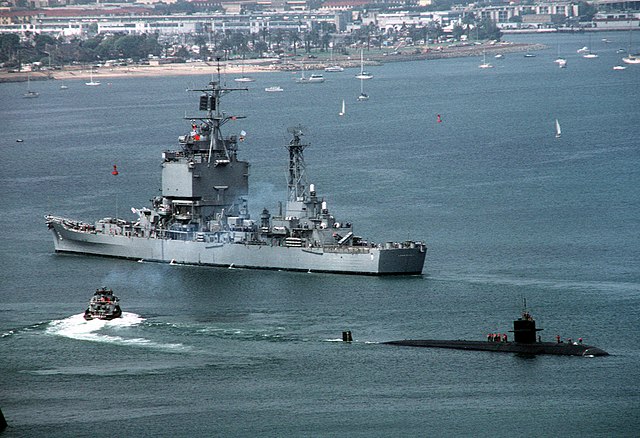
USS_Long_Beach_and_USS_La_Jolla_San_Diego_in_1982
In 1980 she rescued 114 Vietnamese boat people off Vietnam and by 9 January 1980 started her mid-life conversion: The SCANFAR system was removed, new flagship facilities installed in their place, and modern radars, Standard SM-2ER missile system and complete internal overhaul, plus the nuclear core change, plus CIWS, Harpoon and Tomahawk missiles installed. On 13 January 1984 after her refresher cruiser and extensive training with her new weapons systems and electronics, she started her 10th West Pacific deployment. On 9 January 1985 she was Selected for Restricted Availability at Bremerton, Washington. On 13 May 1986 she made her 11th West Pacific deployment and on 25 July 1987 the 12th West Pacific deployment. On 19 October 1987 she Participated in Kuwaiti tanker reflagging and provided cover during Operation Nimble Archer. She also escorted the USS Missouri (BB-63) task force and returned to aicraft carrier escort during the Gulf War of 1991.
Modifications

USS_Long_Beach_underway_off_the_coast_of_Southern_California_21_June_1989
In 1963 already as ordered by pdt. Kennedy, two 1 127mm/38 5-in Mk 30 cannons were installed amidship, and two Mk 35 radars for their fire control.
In 1968 she was fitted with the SPS-12 radar.
In 1978 her twin Talos SAM launcher was removed and two SPG-49/SPW-2 radars installed, to serve two quad Harpoon SSM (8 RGM-84A)
In April 1983 she underwent her major upgrade, with the removal of her twin Terrier SAM, of her SPS-32, SPS-33, SPS-10, and four SPG55C radars, SQS-23 sonar but she gained a WLR-1, WLR-3 ECM suites, and two Mk 28 decoy RL. She obtained also two quad Tomahawk Cruise Missile (8 BGM-109A), and two twin Standard SM-2ER SAM (120 RIM-67) plus two 6-tubes rotative 20mm/76 Mk 15 Phalanx, plus the LN-66, SPS-48C, SPS-49, SPS-67 radars, four SPG-55D radars FCS, and two Mk 90 radars FCS, the SQQ-23B sonar and SLQ-32(v)3 ECM suite and four Mk 36 SRBOC decoy chaff rocket Launchers.
Later years
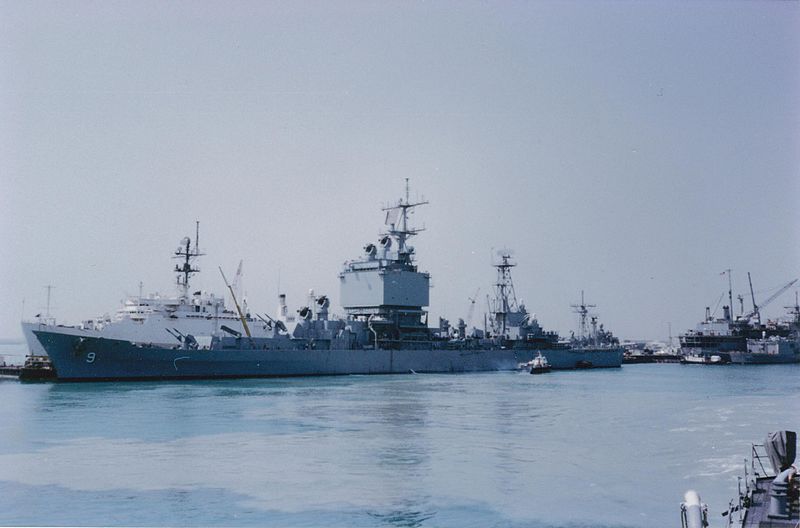
USS-Long-Beach-Persian-Gulf-1991
In May 1991, she supported Operation Provide Comfort, after Desert Storm and after the hostilities ceased. In June, 1991, she took part in Operation Fiery Vigil, an evacuation of U.S. military personnel from two bases in the Philippines: Clark and Subic Bay during the Mount Pinatubo explosion. Plan to fully upgrade her with a modernized version of the Aegis Combat System was axed by defense budget cuts following the end of the cold war. The higher operating costs wand larger crew were pointed out. She costed twice as much as a conventional cruiser. It was decided to have her decommissioned, but also all nuclear cruisers, when their core needed replacement. From now, the Ticonderoga would complement the Arleigh Burke, all with Aegis, as standards. Even frigates were decommissioned. Her last refuelling was scheduled for 1992 refits but she was decommissioned in 1994.

USS_Abraham_Lincoln_battle_group_longbeach_underway_Pacific_Ocean_1_June_1991
The deactivation ceremony took place on 2 July 1994 at Norfolk NAS, after which she was towed over to Newport News for long term upkeep. Her entire superstructure was removed, reactors defueled and by the winter of 1995 the hull was towed through Panama to Puget Sound, stricken on 1 May 1995. On 13 July 2012 she was sold at auction for recycling under Code 350. Incidents linked to her propulsion were few: There was a crew member exposed to abnormal levels in 1963 and radioactive coolant leakages detected in 1991 while crew members alleged her reactor was now unsafe. She was broken up and only a few elements survived to be displayed.
AEGIS Cruiser proposal

Initial DARPA’s 1973 10,000 tonnes concept
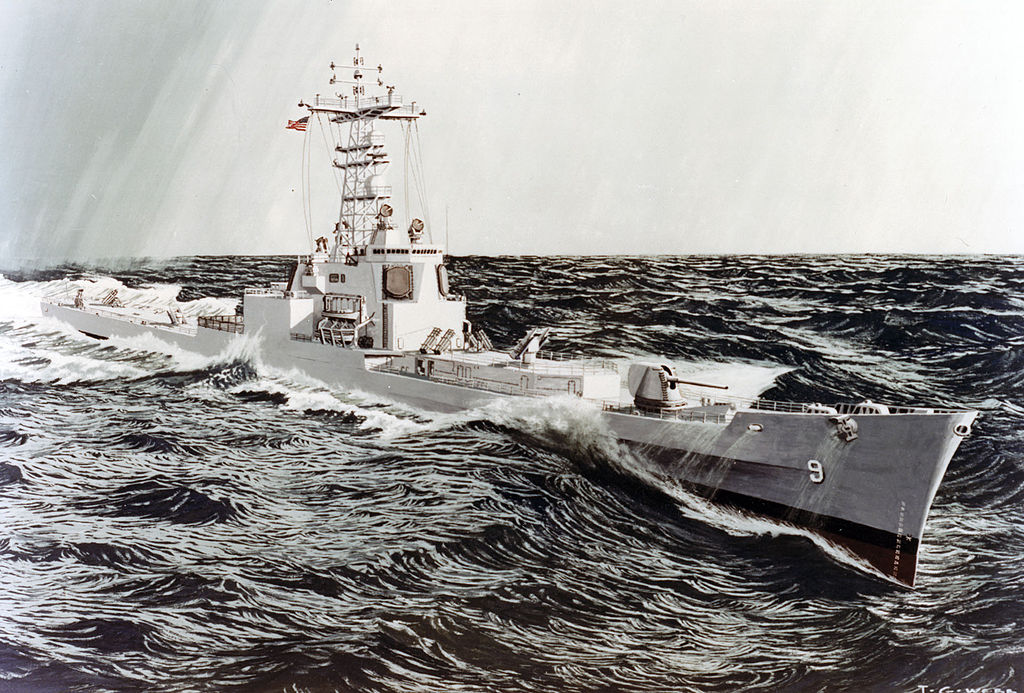
USS Long Beach/Aegis (CGN-9) AAW Refit for FY77-78-79 con,cept artist

17,000 tonnes 1976 design
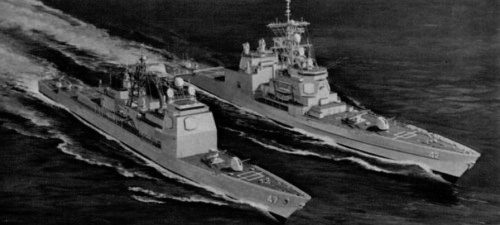

A comparison with the Ticonderoga class
In the late 1970s, DARPA proposed to the USN a new warship concept called the “Strike Cruiser” provisionally designated CSGN. This was an evolution of the California and Virginia class, most importantly an upgrade to the concept of nuclear cruiser responsing to the Soviet Kirov class cruisers perhaps in a better way than four old battleships.
The new 17,000t vessel main asset was its new Aegis combat system and a pair of twin Mk26 missile launchers with Standard and ASROC missiles and four quad Harpoon canister plus eight Tomahawk land/anitship cruise missiles plus the Mark 71 8-inch gun. She would have been fitted also with a hull-mounted and towed sonar systems plus the usual 324 mm M48 torpedo tubes, and two LAMPS helicopters.
But in the context of 1976, cost-cuttings were rampant, and the cost of a single ship was estimated at $1.37 billion, for a completion in December 1983 if USS Long Beach was converted, while total cost for a brand new nuclear powered cruiser to this standard was estimated $3 billion. In fact USS Long Beach was to be the prototype of this new class, keeping her actual armament, upgraded but with AEGIS and her reconstruction cost was estimated $800 million. But US Congress refused the option, preferring the alternative plan of an AEGIS-equipped Spruance class destroyer which evolved into a new cruiser class, the Ticonderogas.
There were two more proposals for a “Strike Cruiser” afterwards, one being a hybrid aviation cruiser, flying AV8 Harrier and answering the Soviet Kiev class, the other was called CGN-42, and was a longer derivative of the Virginia class with Aegis. Both were also rejected by the Congress which stuck to the Ticonderoga class. The Kirov and Kiev class never got equivalents in the USN.
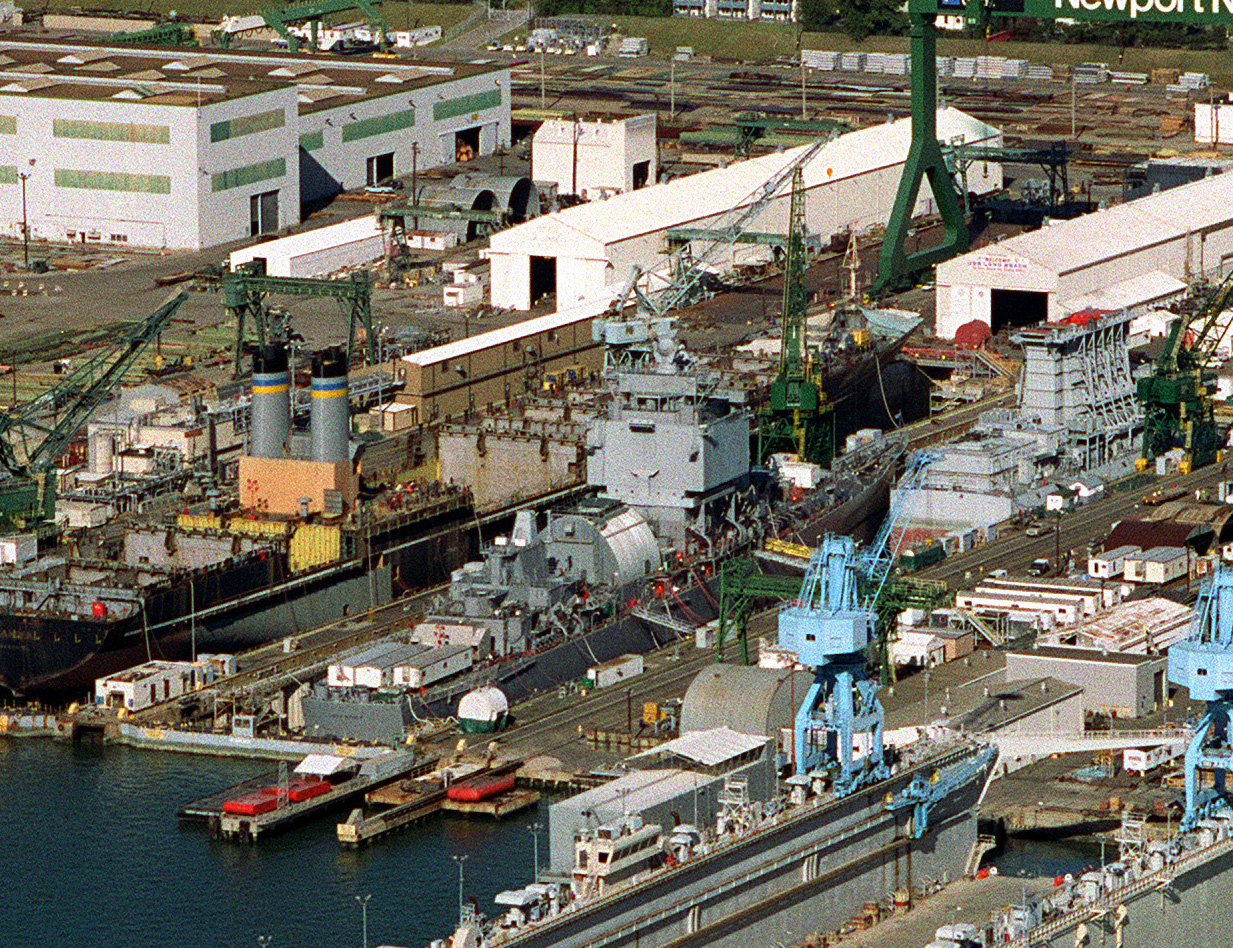
LongBeach-Newport_News_Shipyard_Oct_1994
Read More/Src
on navypedia.org
Cold war US cruisers
Strike from the Sea, The Development and Deployment of Strategic Cruise Missiles since 1934 By Norman Polmar and John O’Connell
secretprojects.co.uk
alternatehistory.com
Ship_Characteristics_Board
On navy-matters.blogspot.com
Nuclear Or Conventional Power for Surface Combatant Ships?: Department of Defence.
UK take on nuclear propulsion for ships (pdf) osti.gov
On world-nuclear.org
Nuclear Naval Propulsion – Magdi Ragheb
uss long beach wiki
hc7seadevils.org

 Latest Facebook Entry -
Latest Facebook Entry -  X(Tweeter) Naval Encyclopedia's deck archive
X(Tweeter) Naval Encyclopedia's deck archive Instagram (@navalencyc)
Instagram (@navalencyc)





 French Navy
French Navy Royal Navy
Royal Navy Russian Navy
Russian Navy Armada Espanola
Armada Espanola Austrian Navy
Austrian Navy K.u.K. Kriegsmarine
K.u.K. Kriegsmarine Dansk Marine
Dansk Marine Nautiko Hellenon
Nautiko Hellenon Koninklije Marine 1870
Koninklije Marine 1870 Marinha do Brasil
Marinha do Brasil Osmanlı Donanması
Osmanlı Donanması Marina Do Peru
Marina Do Peru Marinha do Portugal
Marinha do Portugal Regia Marina 1870
Regia Marina 1870 Nihhon Kaigun 1870
Nihhon Kaigun 1870 Preußische Marine 1870
Preußische Marine 1870 Russkiy Flot 1870
Russkiy Flot 1870 Svenska marinen
Svenska marinen Søværnet
Søværnet Union Navy
Union Navy Confederate Navy
Confederate Navy Armada de Argentina
Armada de Argentina Imperial Chinese Navy
Imperial Chinese Navy Marinha do Portugal
Marinha do Portugal Mexico
Mexico Kaiserliche Marine
Kaiserliche Marine 1898 US Navy
1898 US Navy Sovietskiy Flot
Sovietskiy Flot Royal Canadian Navy
Royal Canadian Navy Royal Australian Navy
Royal Australian Navy RNZN Fleet
RNZN Fleet Chinese Navy 1937
Chinese Navy 1937 Kriegsmarine
Kriegsmarine Chilean Navy
Chilean Navy Danish Navy
Danish Navy Finnish Navy
Finnish Navy Hellenic Navy
Hellenic Navy Polish Navy
Polish Navy Romanian Navy
Romanian Navy Turkish Navy
Turkish Navy Royal Yugoslav Navy
Royal Yugoslav Navy Royal Thai Navy
Royal Thai Navy Minor Navies
Minor Navies Albania
Albania Austria
Austria Belgium
Belgium Columbia
Columbia Costa Rica
Costa Rica Cuba
Cuba Czechoslovakia
Czechoslovakia Dominican Republic
Dominican Republic Haiti
Haiti Hungary
Hungary Honduras
Honduras Estonia
Estonia Iceland
Iceland Eire
Eire Equador
Equador Iran
Iran Iraq
Iraq Latvia
Latvia Liberia
Liberia Lithuania
Lithuania Mandchukuo
Mandchukuo Morocco
Morocco Nicaragua
Nicaragua Persia
Persia San Salvador
San Salvador Sarawak
Sarawak Uruguay
Uruguay Venezuela
Venezuela Zanzibar
Zanzibar Warsaw Pact Navies
Warsaw Pact Navies Bulgaria
Bulgaria Hungary
Hungary

 Bundesmarine
Bundesmarine Dutch Navy
Dutch Navy Hellenic Navy
Hellenic Navy Marina Militare
Marina Militare Yugoslav Navy
Yugoslav Navy Chinese Navy
Chinese Navy Indian Navy
Indian Navy Indonesian Navy
Indonesian Navy JMSDF
JMSDF North Korean Navy
North Korean Navy Pakistani Navy
Pakistani Navy Philippines Navy
Philippines Navy ROKN
ROKN Rep. of Singapore Navy
Rep. of Singapore Navy Taiwanese Navy
Taiwanese Navy IDF Navy
IDF Navy Saudi Navy
Saudi Navy Royal New Zealand Navy
Royal New Zealand Navy Egyptian Navy
Egyptian Navy South African Navy
South African Navy






























 Ukrainian Navy
Ukrainian Navy dbodesign
dbodesign